Fatigue Performance Evaluation of Warm-Mixed Rubber Asphalt Mixture for Stress Absorption Layer in Cold Area
Abstract
1. Introduction
2. Materials and Methods
2.1. Materials
2.1.1. Production of Rubber Asphalt
2.1.2. Selection of Aggregates
2.1.3. Determination of Aggregate Gradation
2.1.4. Determination of the Optimum Amount of Asphalt
2.1.5. Determination of Optimum Mixing and Compaction Temperature
2.2. Methods
2.2.1. Effect of Warm-Mixed Material on Road Performance of Rubber Asphalt Mixture
2.2.2. Test Scheme and Parameters of Four-Point Loading Trabecular Bending Fatigue Test
Test Scheme
Test Parameters
Aging Treatment Method of Asphalt Mixture
- The influence of temperature
- 2.
- The comprehensive role of environmental factors
- 3.
- Effect of aging on microstructure
- 4.
- The role of warm-mixed agent
- 5.
- Physical and chemical changes in the aging process
- 6.
- Effect of aging on fatigue properties
3. Results and Discussion
3.1. Optimum Content Determination and Performance of Warm-Mixed Agent
3.1.1. Needle Penetration Test
3.1.2. Softening Point Test
3.1.3. Ductility Test
3.1.4. Elastic Recovery Test
3.1.5. Low-Temperature Trabecular Bending Test
3.2. Analysis of Influence of Warm-Mixed on Road Performance of Rubber Asphalt Mixture
3.3. Fatigue Test Results and Analysis of Warm-Mixed Rubber Asphalt Mixture Used as Stress Absorption Layer
3.3.1. Fatigue Life of Specimens with Different Gradations
3.3.2. Fatigue Life of Specimens with Different Asphalt Content
3.3.3. Fatigue Life of Specimens with Different Strain Levels
3.3.4. Comparison and Analysis of Fatigue Life of Warm-Mixed and Hot-Mixed Rubber Asphalt Mixture
3.3.5. Effect of Aging on Fatigue Performance of Warm-Mixed and Hot-Mixed Mixture
3.3.6. Comparison and Analysis of Fatigue Life of Three Kinds of Asphalt Mixture
4. Summary and Conclusions
- The fatigue life of warm-mixed rubber asphalt mixture used as stress absorption layer is in the following order: gradation Ⅱ > gradation Ⅲ > gradation Ⅰ, and the fatigue life of warm-mixed rubber asphalt mixture corresponding to gradation Ⅱ is the highest. When the amount of rubber asphalt reaches the optimum amount of asphalt, the warm-mixed rubber asphalt mixture corresponding to gradation Ⅱ can obtain the maximum fatigue life. Under the condition of low strain, the warm-mixed rubber asphalt mixture has a longer fatigue life, and when the strain increases, the fatigue life decreases.
- The fatigue life linear regression characteristics of warm-mixed and hot-mixed rubber asphalt mixture used as stress absorption layer are good, and the fatigue performance of hot-mixed rubber asphalt mixture is slightly better than that of warm-mixed rubber asphalt mixture.
- After aging, the fatigue life sensitivity of warm-mixed and hot-mixed rubber asphalt mixture becomes smaller, and the change of fatigue life sensitivity of warm-mixed rubber asphalt mixture is less than that of hot-mixed rubber asphalt mixture. The sensitivity of rubber asphalt mixture to applied strain level changes little with the change of hot-mixed and warm-mixed. After aging, the fatigue endurance reduction rate of hot-mixed rubber asphalt mixture is much faster than that of warm-mixed rubber asphalt mixture; warm-mixed agent can slow down the decrease rate of fatigue performance of rubber asphalt mixture and improve the aging resistance of rubber asphalt mixture.
- The fatigue life–strain level curves of the three kinds of asphalt mixtures used as stress absorption layer show a good linear relationship. The fatigue performance of the warm-mixed rubber asphalt mixture is basically the same as that of the hot-mixed rubber asphalt mixture, but much higher than those of the SBS-modified asphalt mixture. The sensitivity of fatigue life of warm-mixed rubber asphalt mixture to strain level is slightly higher than that of hot-mixed rubber asphalt mixture, but much less than that of SBS-modified asphalt mixture. SBS-modified asphalt mixture is the most sensitive to strain levels.
Funding
Data Availability Statement
Conflicts of Interest
References
- Chang, H. Performance of rubber asphalt stress absorbing layer used to prevent reflection cracks. China Highw. 2023, 15, 116–117. [Google Scholar]
- Quan, D. Study on the application of rubber asphalt mixture in municipal pavement repair engineering. Fujian Build. Mater. 2023, 256, 13–16. [Google Scholar]
- Deng, G. Rearch on Fatigue Performance and Damage Mechanism of Asphalt Under Repetitive Loading with Variable Stresses. Master’s Thesis, South China University of Technology, Guangzhou, China, 2023; pp. 3–5. [Google Scholar]
- Zhao, Y. Application of High Elastic Asphalt in Stress Absorption Layer. Master’s Thesis, Southwest Jiaotong University, Guangzhou, China, 2021; pp. 1–3. [Google Scholar]
- Chen, Q.; Lin, Y. Study on the Effect of Different Warm Mixing Agents on Property of Warm-mixed Rubber Asphalt Mixture. J. Munic. Technol. 2022, 40, 164–168. [Google Scholar]
- Nan, Y. Experimental study on properties of warm mixed rubber modified asphalt mixture. Fujian Transp. Technol. Basic Inf. 2021, 53–56. [Google Scholar]
- Zhang, L.; Meng, H.; Li, Y.; Wang, H.; Wang, S. Experimental Study on Engineered High-content Rubber Asphalt Performance. J. Highw. Transp. Res. Dev. 2024, 41, 71–78. [Google Scholar]
- Ma, T. Application of high performance stress absorbing layer in highway engineering. Jiangxi Build. Mater. 2024, 17, 27–30. [Google Scholar]
- Li, Y.; Chen, J.; Wang, S.; Huang, M.; Huang, K. Multi-scale research nn mechanical characteristics of splitting fatigue damage of asphalt mixture. J. Changsha Univ. Sci. & Technol. (Nat. Sci.) 2022, 19, 1–10. [Google Scholar]
- Liu, J. Study on fatigue performance of all-thick asphalt pavement. TranspoWorld 2022, 36, 90–92. [Google Scholar]
- Bai, X.; Yuan, F.; Shi, P. Development of a ternary composite asphalt warm mix. J. Suzhou Univ. Sci. Technol. (Nat. Sci. Ed.) 2022, 39, 51–56. [Google Scholar]
- Yang, G.; Chen, Q.; Li, Y.; Bao, X. Thermal stability analysis of warm mixed rubber asphalt. TranspoWorld 2022, 11, 24–26. [Google Scholar]
- Wang, W.; Qiu, Y. Present stituation and prospect of organic reduced sticky additive for warm mix asphalt. New Chem. Mater. 2017, 451, 210–211. [Google Scholar]
- Pan, R. Performance of warm mixed rubber asphalt mixture of stress absorbing layer. J. Chang’an Univ. (Nat. Sci. Ed.) 2019, 39, 49–56. [Google Scholar]
- Feng, X.; Kang, Q. Effect of laboratory compaction method on voidage and mechanical properties of hot mixed asphalt mixture. J. China Foreign Highw. 2020, 40, 291–297. [Google Scholar]
- Ma, Z.; Ji, Z.; Huang, Y.; Zheng, B. Experimental Study on Compaction Temperature of Foam Warrrrrubber Asphalt Mixture. Highway 2020, 65, 279–285. [Google Scholar]
- Guan, H.; Zhang, Q.; Xu, Y.; Chen, S. Laboratory Rutting Test for Bituminous Mixture at Medium Temperature. J. Highw. Transp. Res. Develornnent 2010, 27, 38–42. [Google Scholar] [CrossRef]
- Yan, X.; Zhanu, S.; Li, Y.; Hu, X. Analysis of Temperature Field of Asphalt Pavement by Site Measurement in Full-Depth. Master’s Thesis, Chang’an, China, 2016. [Google Scholar]
- Shen, Q.; Wu, B.; Shen, Y.; Fan, Z. Research on mechanical properties of asphalt mixture fatigue damage under stress control mode. J. Jilin Jianzhu Univ. 2020, 37, 38–44. [Google Scholar]
- Chen, Y. Comparative Study on Fatigue Characteristics of Asphalt Mixture Under Uniaxial Tensile and Four-Pointbending Loading Mode. Master’s Thesis, Chang’an University, Xi’an, China, 2023; pp. 34–37. [Google Scholar]
- Liu, X.; Li, X. Study on Asphalt Mixture Fatigue Performance Using Different Aging Methods. Pet. Asph. 2018, 32, 38–43. [Google Scholar]
- Liao, J. Analysis of fatigue failure criterion of factory mixed hot recycled asphalt mixture. Traffic Technol. Manag. 2023, 4, 47–51. [Google Scholar]
- Liu, Q. Study on the Aging Performance and its Mechanism of High Content Rubber Asphalt Binder. Master’s Thesis, Shijiazhuang Railway University, Shijiazhuang, China, 2024; pp. 17–19. [Google Scholar]
- Liu, J. Study on Bending Fatigue Properties of Rubber Concrete. Master’s Thesis, Shijiazhuang Railway University, Shijiazhuang, China, 2024; pp. 17–19. [Google Scholar]
- Gullibiya, E. Analysis of influence of fine aggregate content on pavement performance of AC-25C asphalt pavement. Hunan Commun. Sci. Technol. 2020, 46, 65–68. [Google Scholar]
- Tian, X.-X. Study on durability of rubber asphalt mixture based on uniaxial compression creep test. Gansu Sci. Technol. 2020, 36, 92–94. [Google Scholar]
- Zhu, Y. Study on The Fatigue Performance of Superpaveasphalt Mixture and Fractional Grey Predictionmodel. Master’s Thesis, Inner Mongolia University, Hohhot, China, 2023; pp. 27–29. [Google Scholar]
- Liang, B.; Lan, F.; Zheng, J. Research and Development of Relationship Between Aging Mechanismand Fatigue Properties of Asphalt. Mater. Rep. 2021, 35, 14. [Google Scholar]
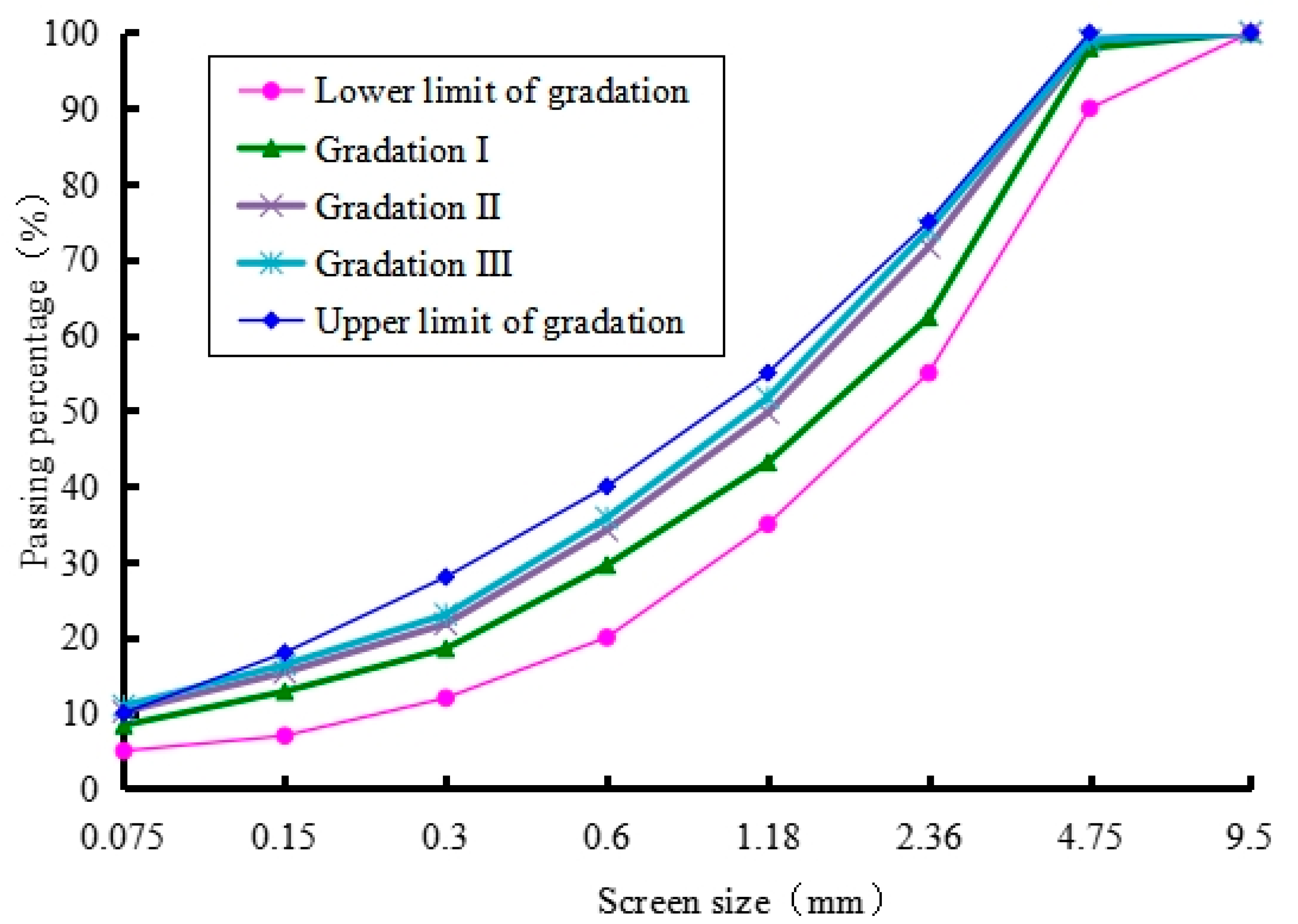
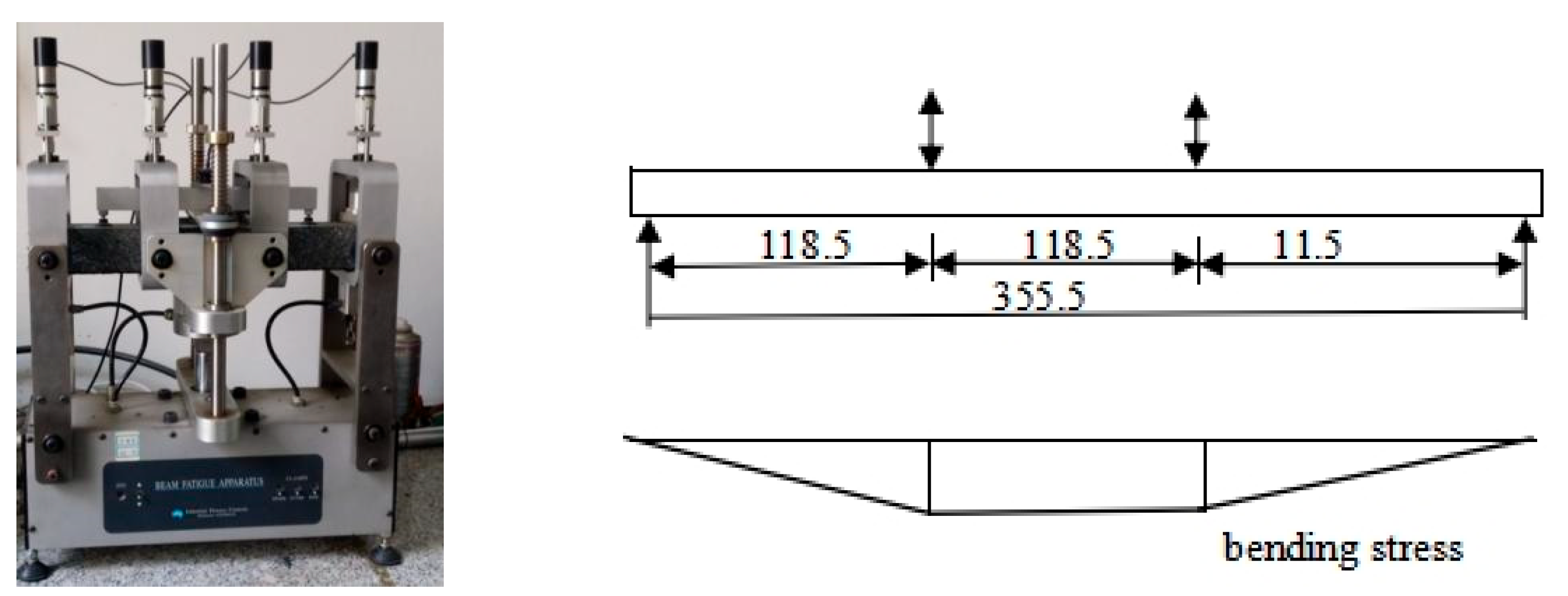


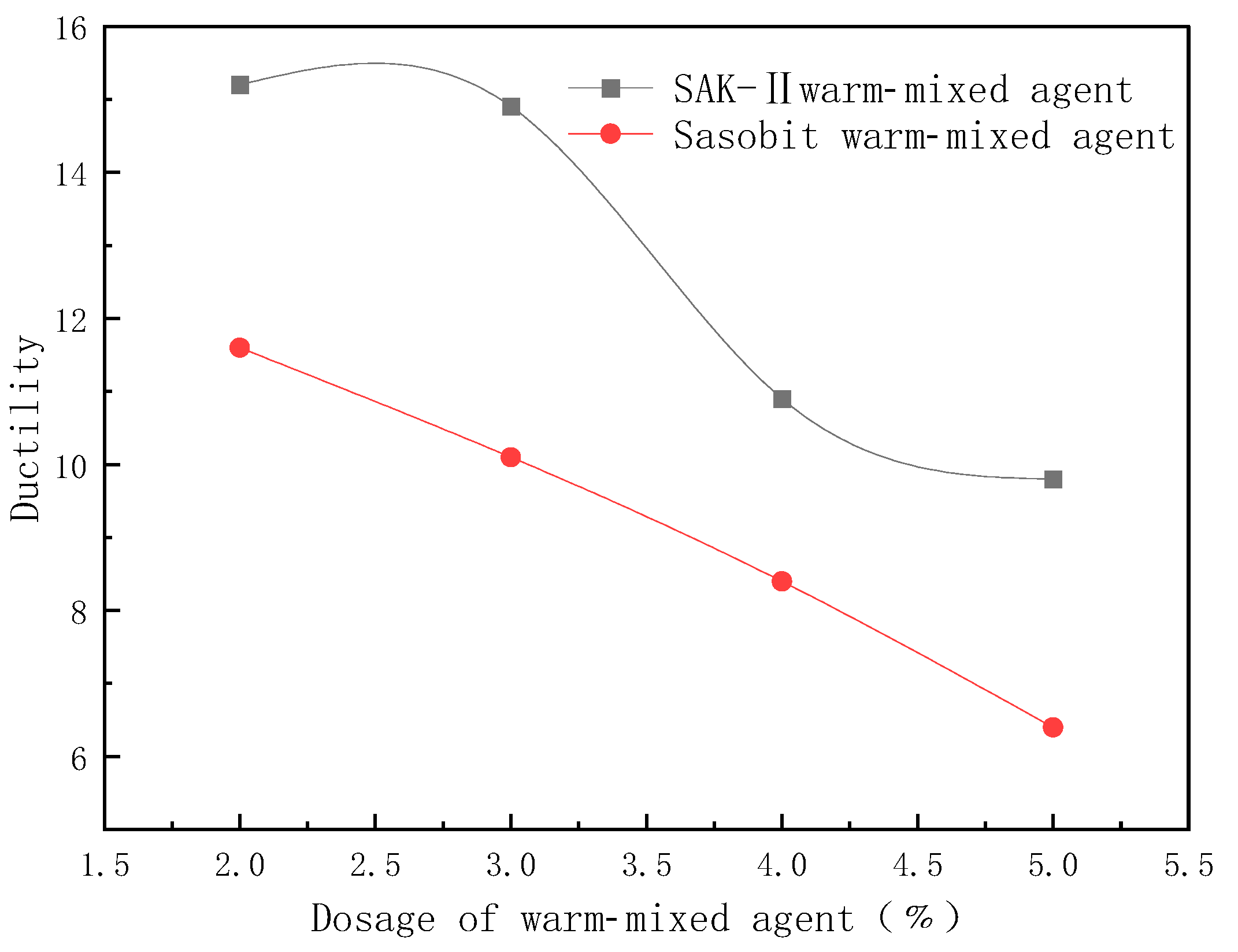


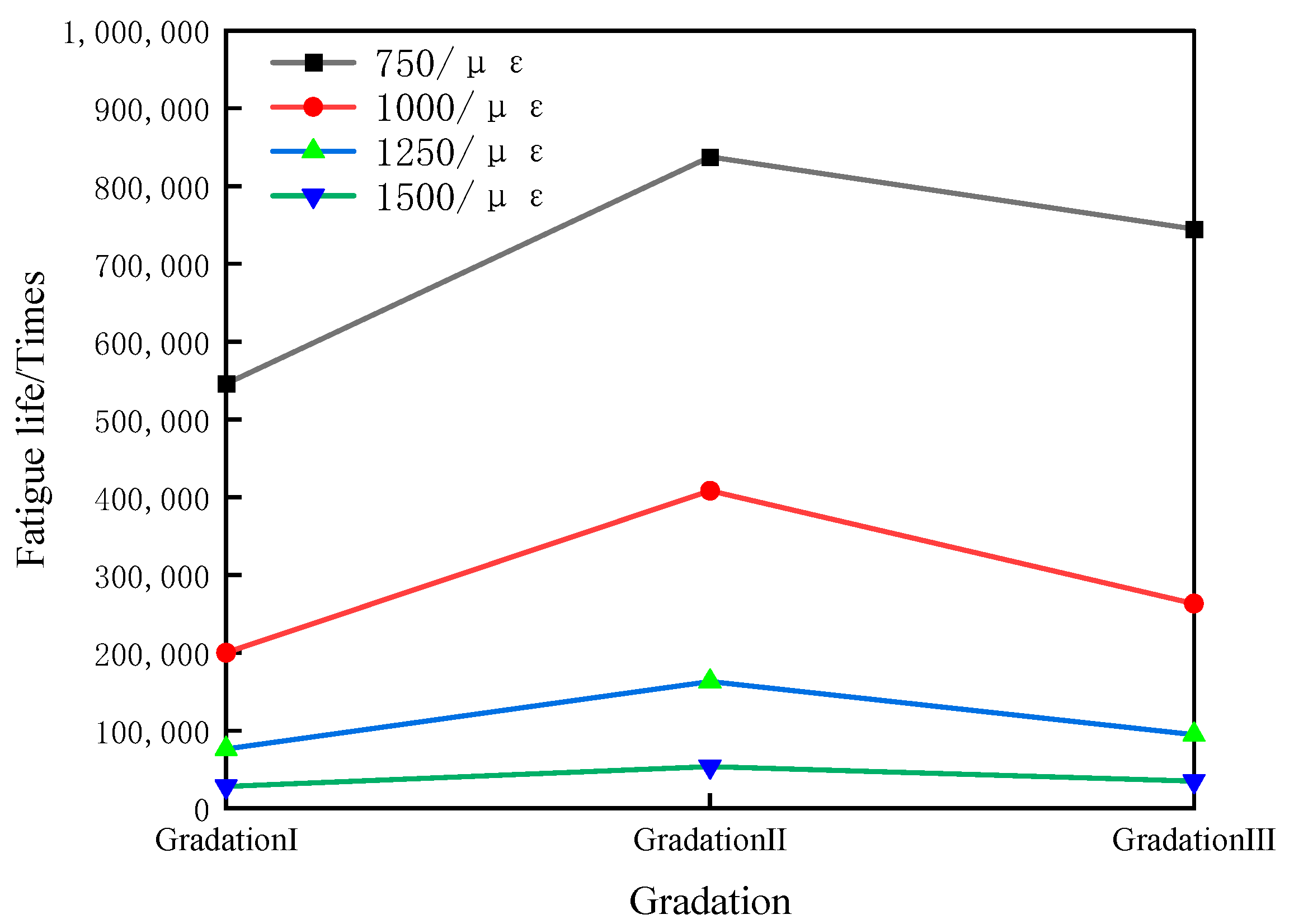
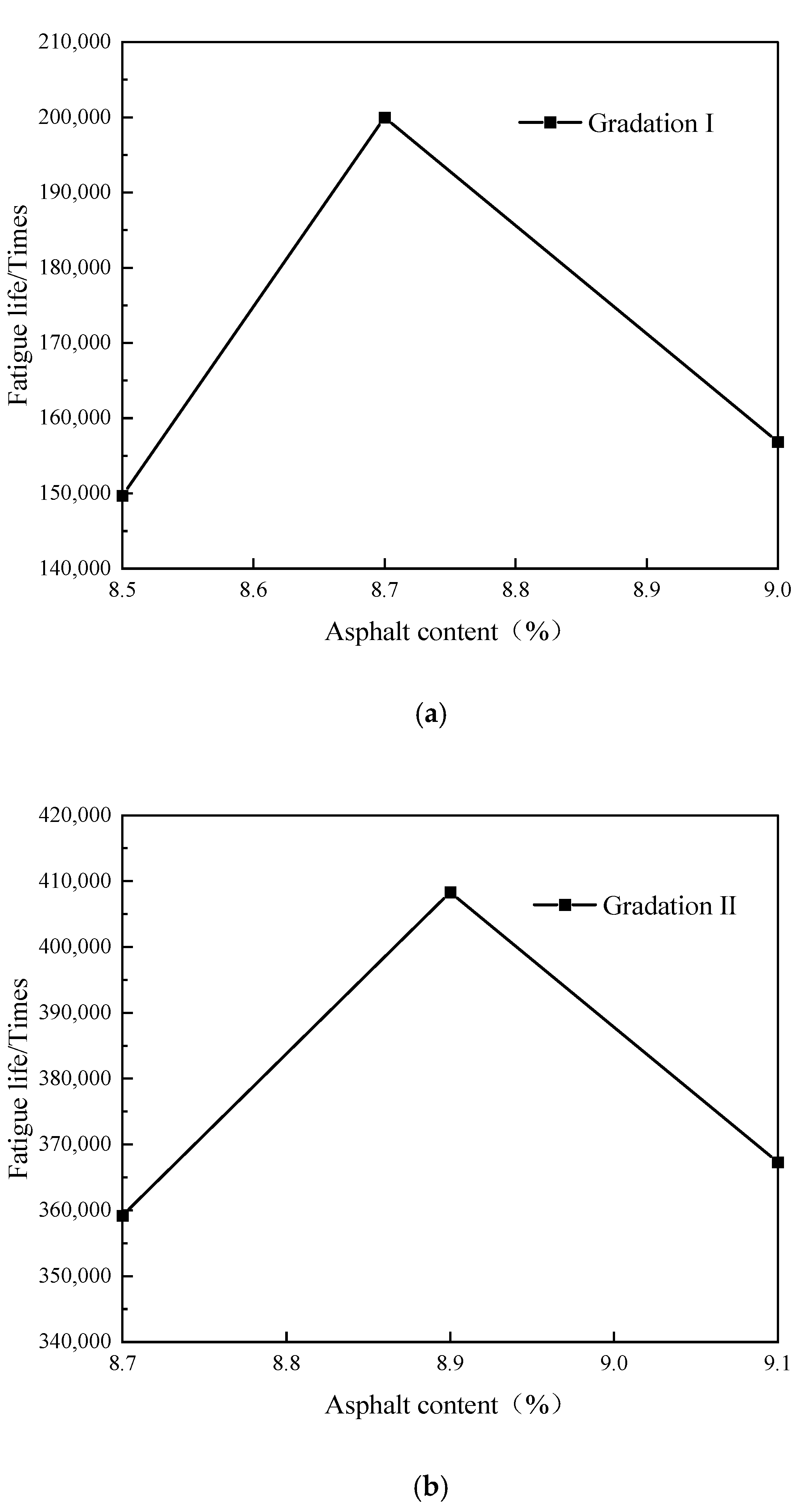

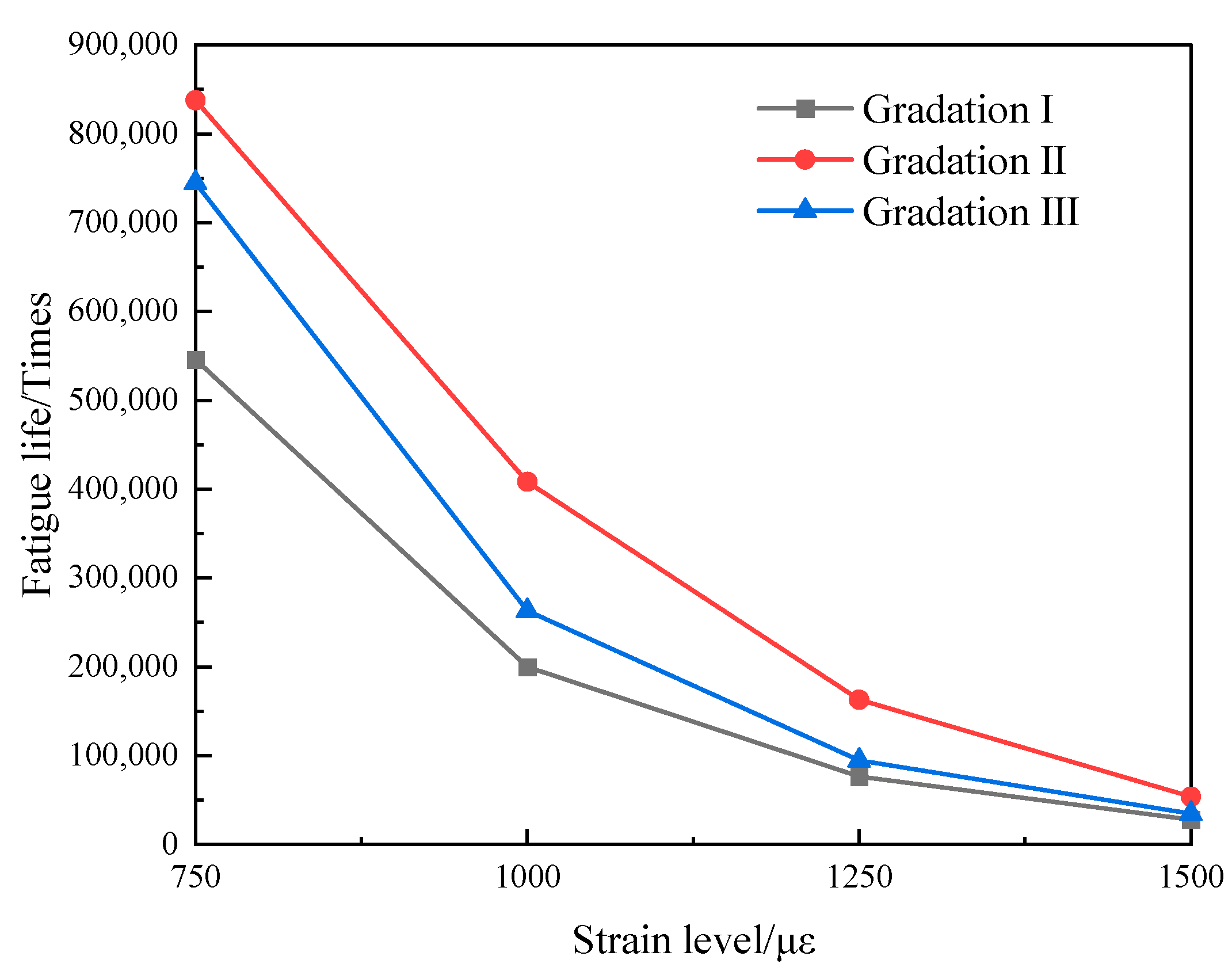
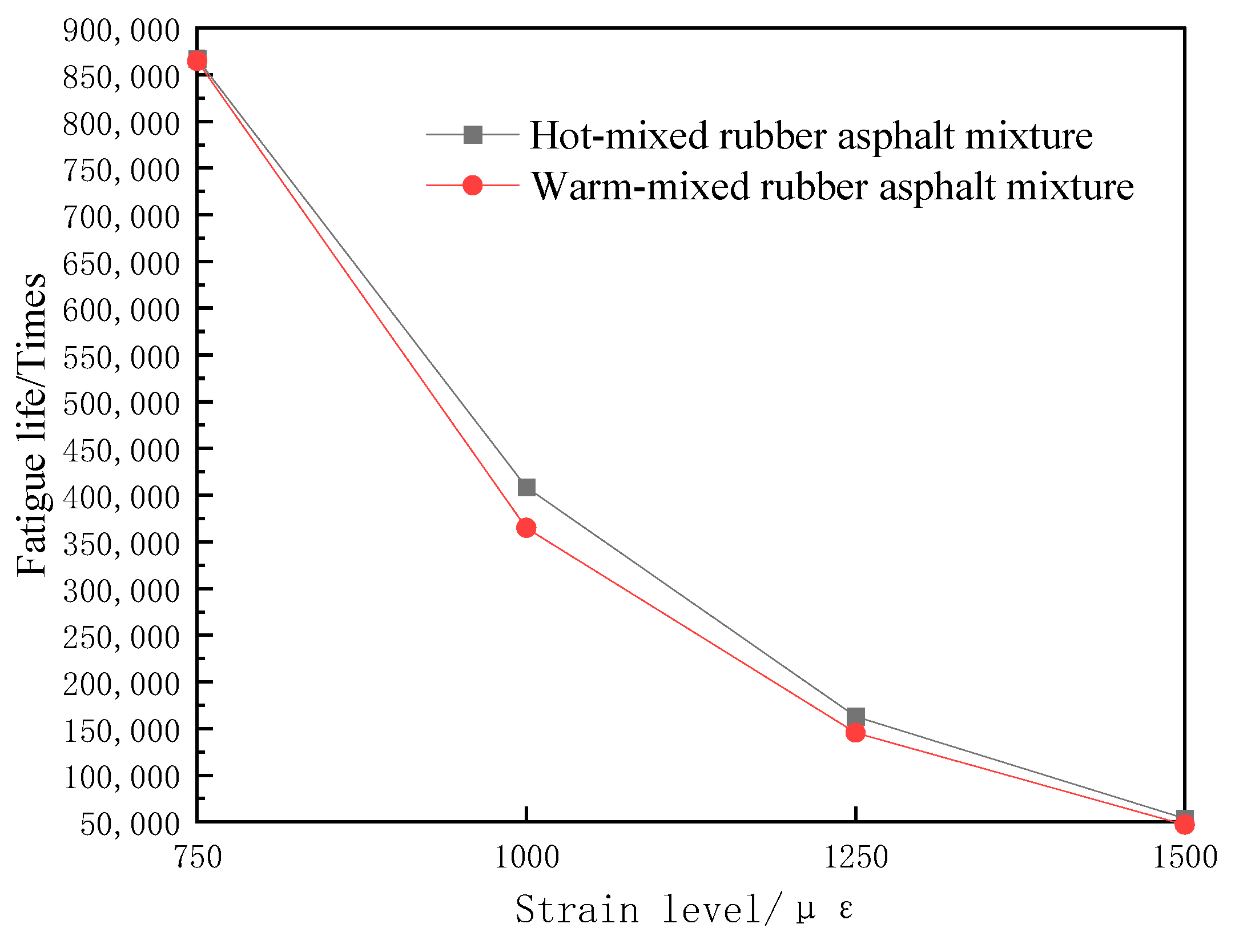
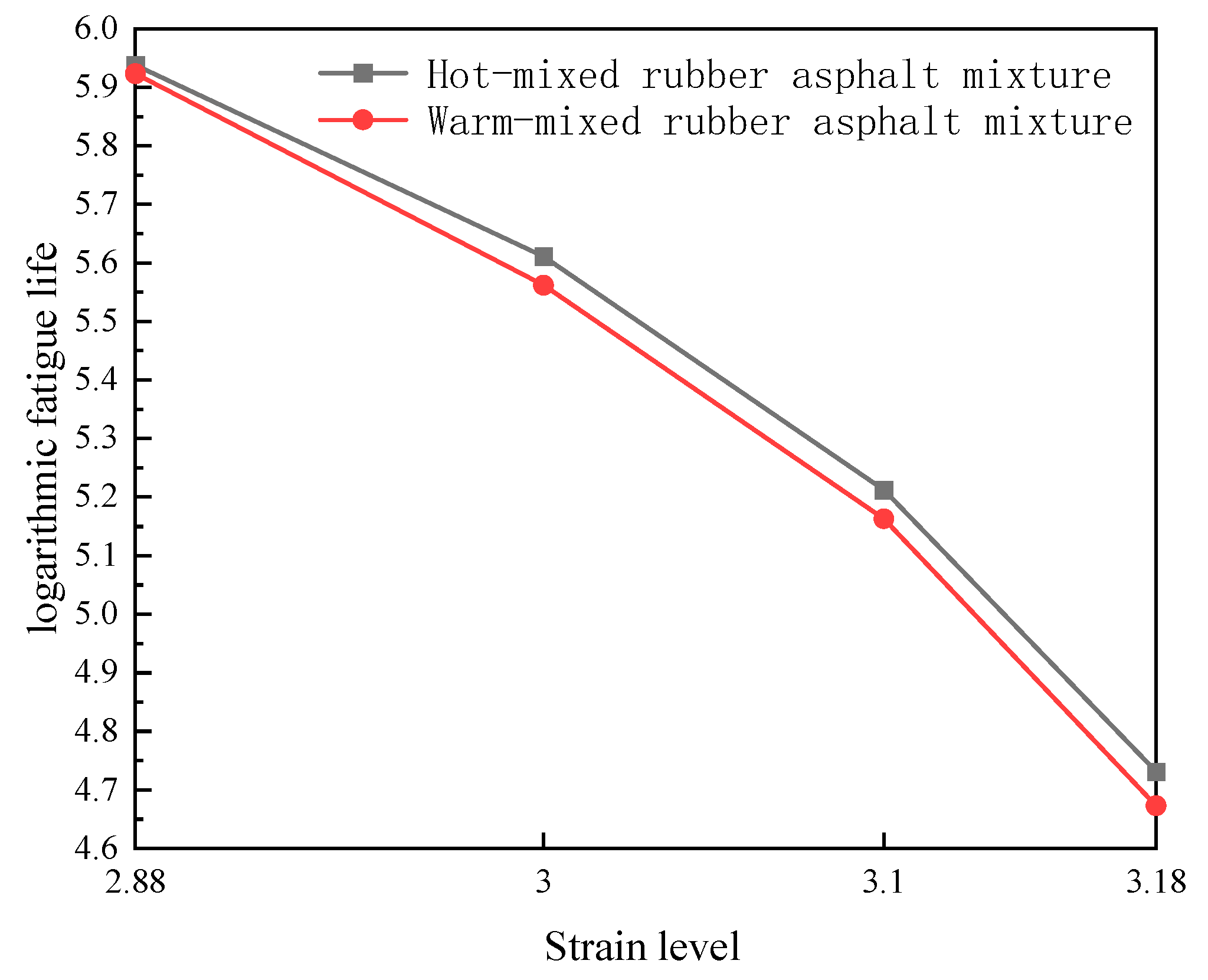


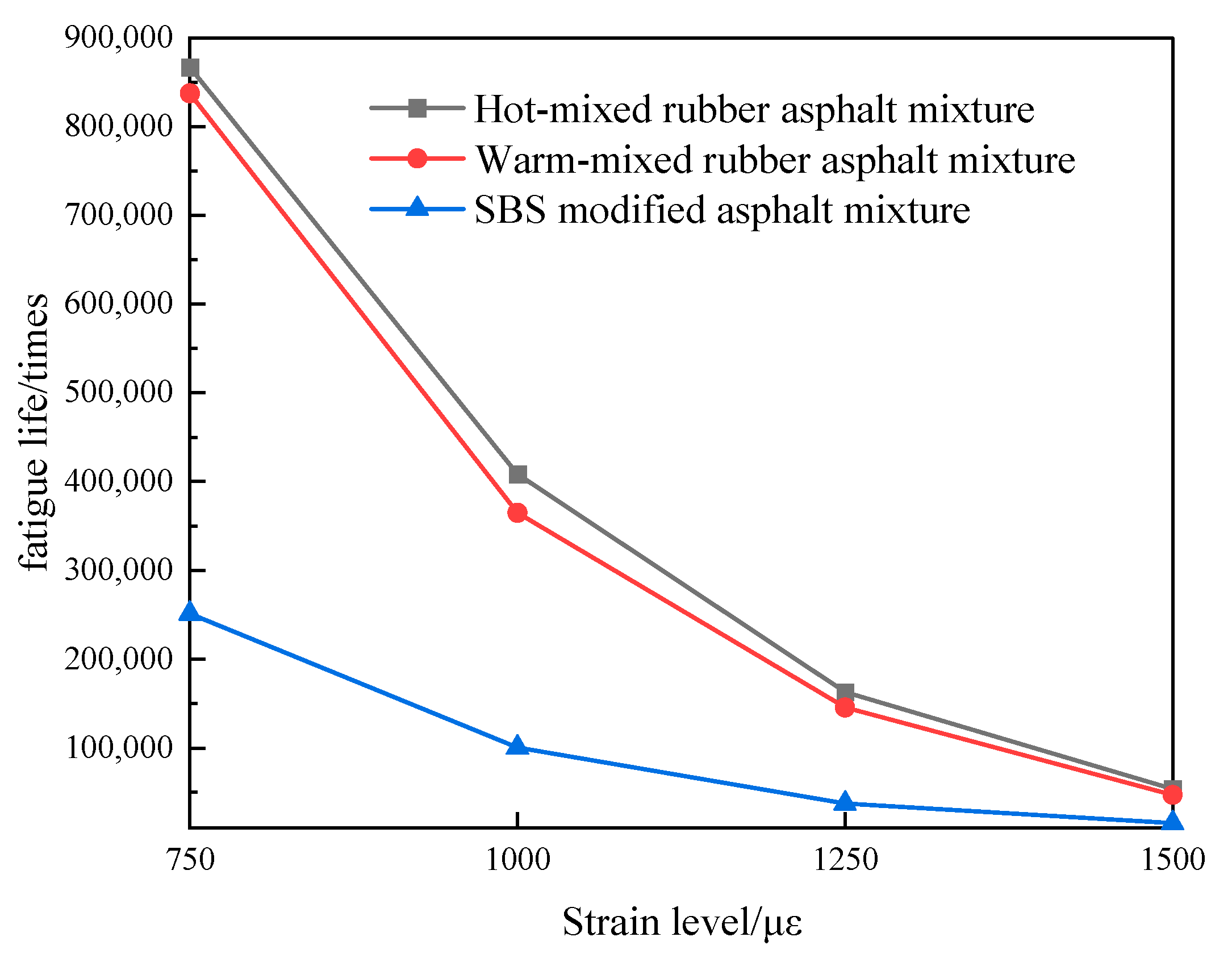

| Test Item | Penetration (0.1 mm) | Ductility (cm) | Softening Point (°C) | Viscosity (Pa·s) | Elastic Recovery (%) |
|---|---|---|---|---|---|
| Measured value | 67 | 17.9 | 63.1 | 2.400 | 89 |
| Technical Index | Unit | I-A | I-B | I-C | I-D |
|---|---|---|---|---|---|
| Needle penetration (25 °C, 100 g, 5 s) | 0.1 mm | ≥60 | |||
| Softening point | °C | ≥65 | |||
| PG rating is not less than | — | PG76-28 | |||
| Ductility of 5 °C | cm | ≥6.5 | |||
| 177 °C Apparent viscosity | Pa·s | ≤4 | |||
| Flash point | °C | ≥230 | |||
| Solubility | % | ≥99 | |||
| Elastic recovery | % | ≥60 | |||
| Gradation | Pass Rate of Each Sieve Hole | |||||||
|---|---|---|---|---|---|---|---|---|
| 9.5 | 4.75 | 2.36 | 1.18 | 0.6 | 0.3 | 0.15 | 0.075 | |
| Gradation Ⅰ | 100.0 | 98.0 | 62.4 | 43.2 | 29.6 | 18.5 | 12.9 | 8.40 |
| Gradation Ⅱ | 100.0 | 98.9 | 71.6 | 49.7 | 34.2 | 21.8 | 15.4 | 10.2 |
| Gradation Ⅲ | 100.0 | 99.1 | 73.9 | 51.7 | 35.8 | 23.0 | 16.4 | 11.0 |
| Inspection Item | Experimental Results | Technical Requirements (Highway Asphalt Pavement Design Code in China) | ||
|---|---|---|---|---|
| Warm-Mixed Rubber Asphalt Mixture | Hot-Mixed Rubber Asphalt Mixture | |||
| Compaction temperature (°C) | 150 | 180 | - | |
| Water stability | Residual stability (%) | 93.48 | 95.51 | >75 |
| Freeze–thaw split intensity ratio (%) | 96.78 | 95.5 | >75 | |
| High-temperature stability | Dynamic stability (times/mm) | 4874 | 3822 | >2400 |
| Low-temperature crack resistance | −23 °C low-temperature trabecular bending failure strain (με) | 4081.0 | 4698.2 | >2800 |
| Mixture Type | Fatigue Life Equation | R2 |
|---|---|---|
| Hot-mixed rubber asphalt mixture | 0.992 | |
| Warm-mixed rubber asphalt mixture | 0.995 |
| Mixture Type | Fatigue Life Equation | R2 |
|---|---|---|
| Hot-mixed rubber asphalt mixture before aging | 0.992 | |
| Hot-mixed rubber asphalt mixture after aging | 0.995 | |
| Warm-mixed rubber asphalt mixture before aging | 0.995 | |
| Warm-mixed rubber asphalt mixture after aging | 0.999 |
| Rubber Asphalt Mixture Type | K (Before Aging) | K (After Aging) | F(k)% |
|---|---|---|---|
| Hot-mixed rubber asphalt mixture | 6.378 | 5.848 | 8.3 |
| Warm-mixed rubber asphalt mixture | 6.367 | 6.066 | 4.7 |
Disclaimer/Publisher’s Note: The statements, opinions and data contained in all publications are solely those of the individual author(s) and contributor(s) and not of MDPI and/or the editor(s). MDPI and/or the editor(s) disclaim responsibility for any injury to people or property resulting from any ideas, methods, instructions or products referred to in the content. |
© 2024 by the author. Licensee MDPI, Basel, Switzerland. This article is an open access article distributed under the terms and conditions of the Creative Commons Attribution (CC BY) license (https://creativecommons.org/licenses/by/4.0/).
Share and Cite
Pan, R. Fatigue Performance Evaluation of Warm-Mixed Rubber Asphalt Mixture for Stress Absorption Layer in Cold Area. Buildings 2024, 14, 3817. https://doi.org/10.3390/buildings14123817
Pan R. Fatigue Performance Evaluation of Warm-Mixed Rubber Asphalt Mixture for Stress Absorption Layer in Cold Area. Buildings. 2024; 14(12):3817. https://doi.org/10.3390/buildings14123817
Chicago/Turabian StylePan, Rui. 2024. "Fatigue Performance Evaluation of Warm-Mixed Rubber Asphalt Mixture for Stress Absorption Layer in Cold Area" Buildings 14, no. 12: 3817. https://doi.org/10.3390/buildings14123817
APA StylePan, R. (2024). Fatigue Performance Evaluation of Warm-Mixed Rubber Asphalt Mixture for Stress Absorption Layer in Cold Area. Buildings, 14(12), 3817. https://doi.org/10.3390/buildings14123817






